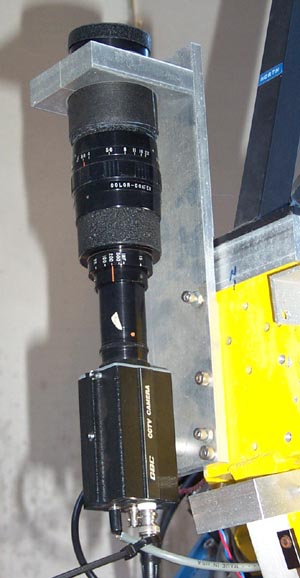The KAIT telescope is located in the dome formerly used by the 24 Inch telescope at Lick Observatory atop Mt. Hamilton, just East of San Jose California. The geodetic postion is taken from Steve Allen's listings
Latitude +37:20:36.04 East Longitude -121:38:05.36 Altitude 1300 meters
Mirror Diameter 76 cm Scale 33.2 arc-seconds per mm Focal Ratio 8.2 North limit +70 degrees (will increase in future) Sourth limit -34 degrees East limit -73 degrees West limit +73 degrees
Pixel size 24.0 microns Pixel scale 0.8 arc-seconds per pixel Number of rows 500 Number of cols 500
The orientation of the images is such that Dec decreases with rows and RA decreases with columns. This means that using the tv command, North is to the top and West is to the right; images have the same handedness as on the sky. With SAOIMAGE North is again to the top, but West is to the left so the handedness is the mirror image of the Palomar print. In FITS jargon NAXIS1 is RA--TAN and NAXIS2 is DEC--TAN.
clear 8mm A1 quartz from Esco U 8mm B 8mm V 8mm R 8mm I 8mm Stromgren u, b, v, y, hbeta unknown thickness CH4 8900 Angstrom H2O+ 6199 Halpha ?mm poor quality filter SII 6725 ?mm p0 polarizer (see below) p45 polarizer p90 polarizer p135 polarizer
Filters are 8mm thick and 1 inch diameter. The UBVRI filters were made by Custom Scientific. (Pre 2000 filters were from Spectro-Film -Billerica MA. to the specifications of Table 6 in Bessell 1990, PASP, 102, page 1181). (BVRI Filters for the old thirty inch were taken from 1983 Schild 1983,P.A.S.P, 95,1021.)
The polarizers are wide band and are mounted so that the axis of the polarizers (in the focal plane) point to the azimuth 0 (North), 45, 90 (East), and 135 degrees. By the axis of the polarizer I mean the orientation similar to the top of polarized sunglasses. (Oriented to minimize dielectric reflections from the road).

Last Updated March 14,2001 by
Email: rtreffers@astro.berkeley.edu